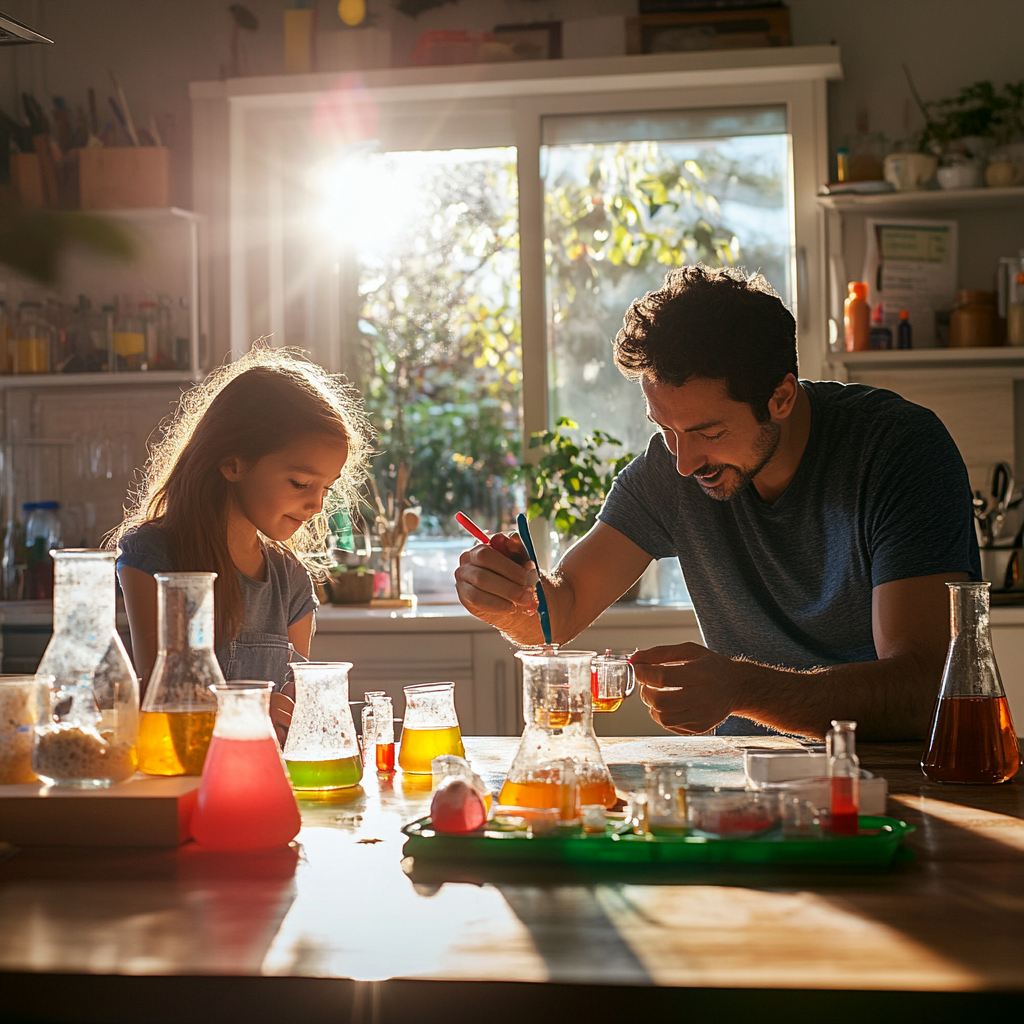1. The Magic of Baking Soda and Vinegar Volcanoes
One of the most classic and exciting science experiments is the baking soda and vinegar volcano. This experiment teaches kids about chemical reactions by combining an acid (vinegar) and a base (baking soda) to create a fizzy eruption.
What You’ll Need:
- Baking soda
- Vinegar
- Dish soap (optional for extra fizz)
- Food coloring (optional)
- A plastic bottle or cup
- A tray or large container to contain the “lava”
How to Do It:
- Place the bottle or cup in a large tray to catch any overflow.
- Fill the container halfway with baking soda.
- Add a few drops of dish soap and food coloring for extra fizz and color.
- Pour vinegar into the container and watch the eruption!
Unique Insight: Encourage your kids to experiment with the amounts of vinegar and baking soda to see how different proportions affect the reaction. This hands-on activity introduces them to the concept of chemical reactions in a visually exciting way.
2. Make Your Own Lava Lamp
Creating a homemade lava lamp is a mesmerizing way to teach kids about the density of liquids and immiscible fluids (liquids that don’t mix). It’s a simple experiment that uses water, oil, and food coloring, with some added fizz for extra effect.
What You’ll Need:
- A clear glass or plastic bottle
- Water
- Vegetable oil
- Food coloring
- Alka-Seltzer tablets
How to Do It:
- Fill the bottle about two-thirds with water.
- Add a few drops of food coloring.
- Pour vegetable oil on top of the water, filling the rest of the bottle.
- Break an Alka-Seltzer tablet into pieces and drop them into the bottle one by one. Watch as the colorful bubbles rise and fall!
Pro Insight: Use this experiment to explain how oil and water don’t mix because they have different densities. The Alka-Seltzer creates bubbles by releasing gas, which makes the colored water rise through the oil, just like in a real lava lamp.
3. DIY Rainbow in a Glass
This experiment is a great way to teach kids about the density of different liquids. By layering sugar water with different concentrations, you can create a colorful rainbow effect in a glass.
What You’ll Need:
- 4 cups or glasses
- Water
- Sugar
- Food coloring
- A spoon
How to Do It:
- Fill each cup with the same amount of water.
- Add a different color of food coloring to each cup.
- In the first cup, add 1 tablespoon of sugar and stir until dissolved. In the second cup, add 2 tablespoons, 3 in the third, and 4 in the fourth.
- Gently pour the layers into a single glass, starting with the most concentrated sugar solution (the one with 4 tablespoons of sugar) and ending with the cup with no sugar. You’ll see the colors stack up!
Unique Insight: Explain how the different sugar concentrations create different densities, allowing the colored liquids to stack on top of each other rather than mix. Kids can try experimenting with different colors or amounts of sugar to see how it affects the results.
4. Floating Egg Experiment
This simple experiment teaches kids about buoyancy by showing them how adding salt to water can make an egg float. It’s a fun way to introduce concepts related to density and buoyancy.
What You’ll Need:
- A glass or jar
- Water
- Salt
- An egg
How to Do It:
- Fill the glass with water and gently place the egg inside. It will sink to the bottom.
- Start adding salt to the water, stirring until it dissolves. Keep adding salt until the egg floats to the top!
Pro Tip: Use this opportunity to explain how the density of the water changes as salt is added, eventually becoming denser than the egg, which makes it float. This experiment is a great introduction to the concept of buoyancy and density for younger kids.
5. Invisible Ink with Lemon Juice
Kids love secret messages, and this classic invisible ink experiment is a perfect way to introduce them to the science of oxidation. With just a lemon and some heat, your kids can write and reveal secret messages.
What You’ll Need:
- Lemon juice
- Cotton swabs or a small paintbrush
- White paper
- A light bulb or heat source
How to Do It:
- Squeeze some lemon juice into a small bowl.
- Dip a cotton swab into the juice and use it to write a message on the white paper.
- Allow the paper to dry completely.
- Hold the paper close to a light bulb or other heat source and watch as the message is revealed!
Unique Insight: Explain to kids that the lemon juice undergoes oxidation when heated, which causes the “ink” to turn brown. This simple but magical experiment introduces kids to the basics of chemical reactions and oxidation.
Conclusion: Science Learning Made Fun
Science experiments at home don’t have to be complicated or expensive. With just a few household items, you can create engaging and educational experiences that spark curiosity and introduce key scientific concepts. From the chemical reaction in a volcano to density experiments with floating eggs, these activities show kids that science is not only fun but also part of everyday life.












